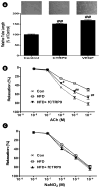C1q/TNF-related proteins, a family of novel adipokines, induce vascular relaxation through the adiponectin receptor-1/AMPK/eNOS/nitric oxide signaling pathway
- PMID: 21836066
- PMCID: PMC3197867
- DOI: 10.1161/ATVBAHA.111.231050
C1q/TNF-related proteins, a family of novel adipokines, induce vascular relaxation through the adiponectin receptor-1/AMPK/eNOS/nitric oxide signaling pathway
Abstract
Objective: Reduced plasma adiponectin (APN) in diabetic patients is associated with endothelial dysfunction. However, APN knockout animals manifest modest systemic dysfunction unless metabolically challenged. The protein family CTRPs (C1q/TNF-related proteins) has recently been identified as APN paralogs and some CTRP members share APN's metabolic regulatory function. However, the vasoactive properties of CTRPs remain completely unknown.
Methods and results: The vasoactivity of currently identified murine CTRP members was assessed in aortic vascular rings and underlying molecular mechanisms was elucidated in human umbilical vein endothelial cells. Of 8 CTRPs, CTRPs 3, 5, and 9 caused significant vasorelaxation. The vasoactive potency of CTRP9 exceeded that of APN (3-fold) and is endothelium-dependent and nitric oxide (NO)-mediated. Mechanistically, CTRP9 increased AMPK/Akt/eNOS phosphorylation and increased NO production. AMPK knockdown completely blocked CTRP9-induced Akt/eNOS phosphorylation and NO production. Akt knockdown had no significant effect on CTRP9-induced AMPK phosphorylation, but blocked eNOS phosphorylation and NO production. Adiponectin receptor 1, but not receptor 2, knockdown blocked CTRP9-induced AMPK/Akt/eNOS phosphorylation and NO production. Finally, preincubating vascular rings with an AMPK-inhibitor abolished CTRP9-induced vasorelaxative effects.
Conclusion: We have provided the first evidence that CTRP9 is a novel vasorelaxative adipocytokine that may exert vasculoprotective effects via the adiponectin receptor 1/AMPK/eNOS dependent/NO mediated signaling pathway.
Figures






Similar articles
-
Irisin improves endothelial function in obese mice through the AMPK-eNOS pathway.Am J Physiol Heart Circ Physiol. 2015 Nov;309(9):H1501-8. doi: 10.1152/ajpheart.00443.2015. Epub 2015 Sep 14. Am J Physiol Heart Circ Physiol. 2015. PMID: 26371167
-
Adiponectin at Physiologically Relevant Concentrations Enhances the Vasorelaxative Effect of Acetylcholine via Cav-1/AdipoR-1 Signaling.PLoS One. 2016 Mar 29;11(3):e0152247. doi: 10.1371/journal.pone.0152247. eCollection 2016. PLoS One. 2016. PMID: 27023866 Free PMC article.
-
C1q/Tumor Necrosis Factor-Related Protein-9 Is a Novel Vasculoprotective Cytokine That Restores High Glucose-Suppressed Endothelial Progenitor Cell Functions by Activating the Endothelial Nitric Oxide Synthase.J Am Heart Assoc. 2024 Feb 20;13(4):e030054. doi: 10.1161/JAHA.123.030054. Epub 2024 Feb 13. J Am Heart Assoc. 2024. PMID: 38348774 Free PMC article.
-
Life history of eNOS: partners and pathways.Cardiovasc Res. 2007 Jul 15;75(2):247-60. doi: 10.1016/j.cardiores.2007.03.023. Epub 2007 Apr 3. Cardiovasc Res. 2007. PMID: 17466957 Free PMC article. Review.
-
eNOS phosphorylation: a pivotal molecular switch in vasodilation and cardioprotection?J Mol Cell Cardiol. 2007 Feb;42(2):280-2. doi: 10.1016/j.yjmcc.2006.10.011. Epub 2006 Dec 18. J Mol Cell Cardiol. 2007. PMID: 17174975 Free PMC article. Review. No abstract available.
Cited by
-
Structural commonality of C1q TNF-related proteins and their potential to activate relaxin/insulin-like family peptide receptor 1 signalling pathways in cancer cells.Br J Pharmacol. 2017 May;174(10):1025-1033. doi: 10.1111/bph.13559. Epub 2016 Aug 11. Br J Pharmacol. 2017. PMID: 27443788 Free PMC article. Review.
-
Ablation of Ctrp9, Ligand of AdipoR1, and Lower Number of Cone Photoreceptors in Mouse Retina.Invest Ophthalmol Vis Sci. 2022 May 2;63(5):14. doi: 10.1167/iovs.63.5.14. Invest Ophthalmol Vis Sci. 2022. PMID: 35575905 Free PMC article.
-
C1q/TNF-related protein 3 (CTRP3) and 9 (CTRP9) concentrations are decreased in patients with heart failure and are associated with increased morbidity and mortality.BMC Cardiovasc Disord. 2019 Jun 10;19(1):139. doi: 10.1186/s12872-019-1117-0. BMC Cardiovasc Disord. 2019. PMID: 31182031 Free PMC article.
-
CTRP13-Mediated Effects on Endothelial Cell Function and Their Potential Role in Obesity.Cells. 2024 Jul 31;13(15):1291. doi: 10.3390/cells13151291. Cells. 2024. PMID: 39120321 Free PMC article.
-
Loss of CTRP1 disrupts glucose and lipid homeostasis.Am J Physiol Endocrinol Metab. 2016 Oct 1;311(4):E678-E697. doi: 10.1152/ajpendo.00087.2016. Epub 2016 Aug 23. Am J Physiol Endocrinol Metab. 2016. PMID: 27555298 Free PMC article.
References
-
- Diamant M, Tushuizen ME. The metabolic syndrome and endothelial dysfunction: common highway to type 2 diabetes and CVD. Curr Diab Rep. 2006;6:279–286. - PubMed
-
- Kim JA, Montagnani M, Koh KK, Quon MJ. Reciprocal relationships between insulin resistance and endothelial dysfunction: molecular and pathophysiological mechanisms. Circulation. 2006;113:1888–1904. - PubMed
-
- Quinones MJ, Nicholas SB, Lyon CJ. Insulin resistance and the endothelium. Curr Diab Rep. 2005;5:246–253. - PubMed
-
- Shimabukuro M, Higa N, Asahi T, Oshiro Y, Takasu N, Tagawa T, Ueda S, Shimomura I, Funahashi T, Matsuzawa Y. Hypoadiponectinemia is closely linked to endothelial dysfunction in man. J Clin Endocrinol Metab. 2003;88:3236–3240. - PubMed
-
- Ouchi N, Ohishi M, Kihara S, Funahashi T, Nakamura T, Nagaretani H, Kumada M, Ohashi K, Okamoto Y, Nishizawa H, Kishida K, Maeda N, Nagasawa A, Kobayashi H, Hiraoka H, Komai N, Kaibe M, Rakugi H, Ogihara T, Matsuzawa Y. Association of hypoadiponectinemia with impaired vasoreactivity. Hypertension. 2003;42:231–234. - PubMed
Publication types
MeSH terms
Substances
Grants and funding
LinkOut - more resources
Full Text Sources
Other Literature Sources
Molecular Biology Databases
Miscellaneous

